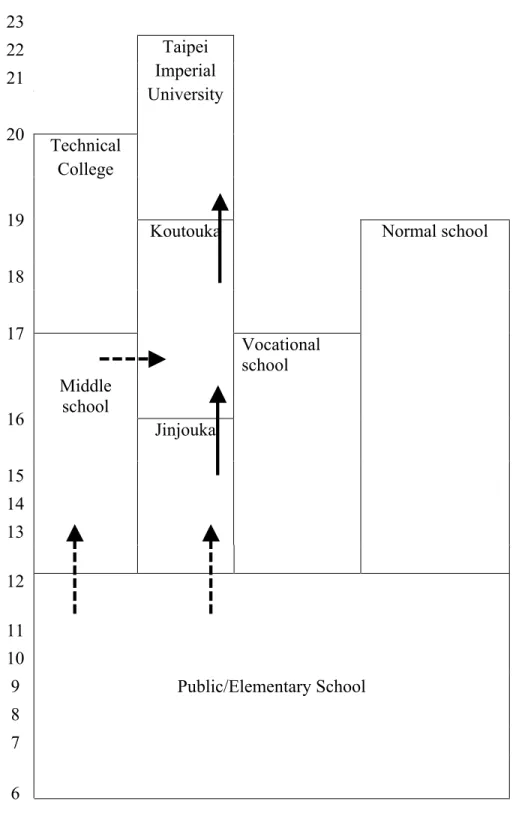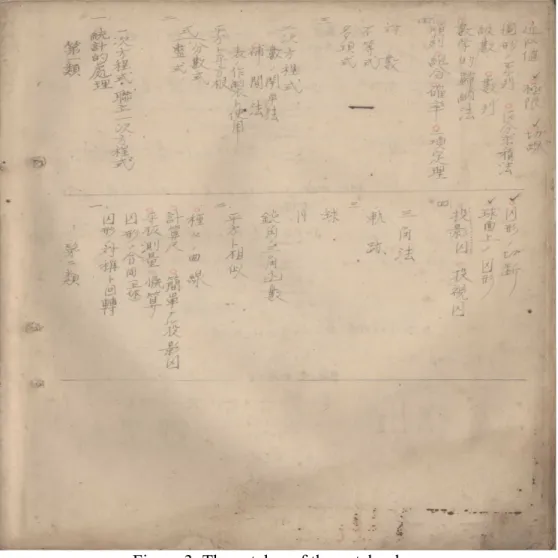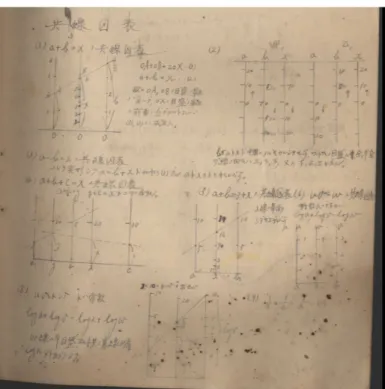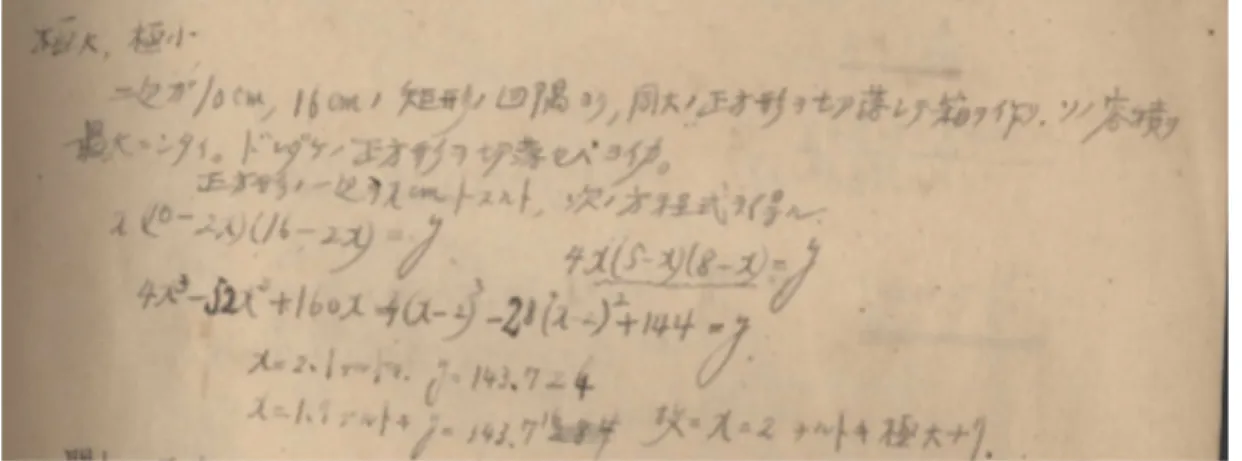HAL Id: hal-01349263
https://hal.archives-ouvertes.fr/hal-01349263
Submitted on 27 Jul 2016
HAL is a multi-disciplinary open access archive for the deposit and dissemination of sci-entific research documents, whether they are pub-lished or not. The documents may come from teaching and research institutions in France or abroad, or from public or private research centers.
L’archive ouverte pluridisciplinaire HAL, est destinée au dépôt et à la diffusion de documents scientifiques de niveau recherche, publiés ou non, émanant des établissements d’enseignement et de recherche français ou étrangers, des laboratoires publics ou privés.
Mathematics education in colonial Taiwan as seen
through a student’s mathematics notebook
Mei-Lun Huang, Jyun-Wei Huang
To cite this version:
Mei-Lun Huang, Jyun-Wei Huang. Mathematics education in colonial Taiwan as seen through a stu-dent’s mathematics notebook. History and Pedagogy of Mathematics, Jul 2016, Montpellier, France. �hal-01349263�
MATHEMATICS EDUCATION IN COLONIAL TAIWAN AS
SEEN THROUGH A STUDENT’S MATHEMATICAL
NOTEBOOK
Mei-Lun HUANG, Jyun-‐Wei HUANG
National Taiwan Normal University, No.88, Ting-chou Road, Sec. 4, Taipei City, Taiwan.
colorguardmary@gmail.com
Taipei Municipal Heping High School, No.100, Wolong Street, Da-an District, Taipei City 106, Taiwan.
austin1119@gmail.com
ABSTRACT
In this article, we will discuss the mathematics pedagogy in the school, Taihoku Kodo Gakko (Taipei High School), established in 1922-1945 with a student’s mathematics notebook that was used in 1944-45. The student’s mathematics “professor” was likely Kato Heizaemon (1891~1975), a researcher of wasan, which is Japanese mathematics in the Edo period. Due to Kato’s background, the contents in the notebook show characteristics of traditional Japanese mathematics. In this study, we will take the topics of the binomial theorem, polynomials, series and approximations as examples to explain how the teacher’s emphasis on numerical approximations reflects the need for practical purposes in mathematics teaching and learning. For instance, the topic of polynomials is devoted more to the methods of estimation and calculation than to the properties of algebraic operations.
1 Introduction
Because of the Treaty of Shimonoseki signed after the First Sino-Japanese War, Taiwan was ceded by Japan. The Empire of Japan governed Taiwan from 1895 to 1945 and reformed the education system and recommend Higher education system which included the westernized mathematical knowledge in this period. In 1922, the first High School1, Taihoku Kodo Gakko (臺北高等學校, Taipei High School), was founded in Taiwan, and the first university, Taihoku Teikoku Taigaku (臺北帝國大學, Taipei Imperial University), was founded in 1928 (Syu, 2012) The Japan government abolished wasan (和算), the traditional mathematics of Japan in Edo period, after the Meiji Restoration and recommend the westernized mathematical knowledge2. Under the influence, the westernized mathematical knowledge was transferred to Taiwan, and the mathematical teachers of Taihoku Kodo Gakko and Taihoku Teikoku Taigaku at that time were all Japanese.
1
High schools in old education system (before 1950) of Japan is different form new education. High schools in old education system of Japan is part of higher education, aiming to educate precollege students, and High schools in new education system of Japan is part of secondary education.
2
Wasan was influence by the mathematics of Song and Yuan Dynasties and had developed into a unique mathematical culture and mathematics activities. Although Wasan and the traditional Chinese mathematics shared the use of Chinese character and some old mathematical questions, but the content of this notebook was mainly western mathematics knowledge not the traditional questions of ancient Chinese.
From the curriculum guidelines at that time,3 we could know that the contents of mathematical learning in Taihoku Kodo Gakko were indeed the westernized mathematical knowledge. Fortunately, we got a notebook written by a student at 1944-1945. Through this notebook, we can know the real mathematical materials in the class. The notebook is an important primary material of mathematical teaching─between professor and students in the classroom─at that time, and was the only one written by student we saved after World War II so far. In this research, we will discuss the background of Taihoku Kodo Gakko first, then sketch the educational institution, the teachers, the curriculum guidelines, and finally focus on the mathematical notebook by which we can discuss the mathematical education characteristics and the related educational purposes of Taihoku Kodo Gakko
2 The background of Taihoku Kodo Gakko
After the Japan government took over Taiwan, they continuously popularized Japanese for the purpose of controlling Taiwan, and pushed Taiwanese to learn Japanese by different kinds of ways (Huang, Jhang, & Wu, 2011). At that time, Taiwanese who used Japanese bad couldn’t learn higher mathematical knowledge through the official education system. In 1922, the Japan government announced the second edition Taiwan Education Instruction (台湾教育令). This document regulated students who possess of the ability of Japanese (including Taiwanese and Japanese students) can obtain the qualification of entering all kinds of schools in Taiwan. The Instruction issued in 1922 decreased the gap between Japanese and Taiwanese students, but still there were discriminations between Taiwanese and Japanese students except students among Taihoku Kodo Gakko. The figure.1 shows the educational system at that time.
Taiwan students who were unable studying abroad must study in the Taihoku Kodo Gakko first in order to enter the only university, Taihoku Teikoku Taigaku. Since Taihoku Kodo Gakko was the only High school in Taiwan, the competition of the entrance examination was very intense (Admission rate of Japanese: 13-40%, Admission rate of Taiwanese: 1%-10%). Most of all students came from cities of Taiwan, 80% of students came from Taipei, and 20% came from others, which included Taichung, Tainan, Kaohsiung, etc. Few of them came from Japan. Moreover, only 9.7% students of all graduates were from public school4 which had been established for Taiwanese (Syu, 2012).
Mathematics classes were took 12% to 15% of all classes in jinjouka5 (尋常科, junior high level) of Taihoku Kodo Gakko. The level is the same as the students who finished the four years curriculum in middle school. The students in koutouka6 (高等科, advanced level) could choose to major in science or liberal arts, and also could choose to learn German or French as second foreign language. The students who major in science had to take 12%~14% mathematics class (Taipei High School of Office of Governor-General of Taiwan, 1936). All mathematics teachers
3
http://hdl.handle.net/2298/1136 4
Public schools in the colonial period was founded for Taiwanese students (or for students who couldn’t use Japanese well), at the same time, Elementary schools was founded for Japanese students (or for students who could use Japanese well).
5
Jinjouka was settled for first 4 year education in 7-year program of High school in old education system of Japan. 6
were Japanese. The mathematics teachers of jinjouka were called kyouyu (教諭, teacher) and of koutouka were called kyouju (教授, professor) (Syu, 2012). It’s worth mentioning that many students would compare the reading quantity to each other under the climate for learning.
23 22 Taipei Imperial University 21 20 Technical College 19
Koutouka Normal school 18 17 Middle school Vocational school 16 Jinjouka 15 14 13 12 Public/Elementary School 11 10 9 8 7 6
Mathematics classes were took 12% to 15% of all classes in jinjouka7 (尋常科, junior high level) of Taihoku Kodo Gakko. The level is the same as the students who finished the four years curriculum in middle school. The students in koutouka8 (高等科, advanced level) could choose to major in science or liberal arts, and also could choose to learn German or French as second foreign language. The students who major in science had to take 12%~14% mathematics class (Taipei High School of Office of Governor-General of Taiwan, 1936). All mathematics teachers were Japanese. The mathematics teachers of jinjouka were called kyouyu (教諭, teacher) and of koutouka were called kyouju (教授, professor) (Syu, 2012). It’s worth mentioning that many students would compare the reading quantity to each other under the climate for learning.
3 Mathematics Education of Taihoku Kodo Gakko in koutouka
The content of mathematic curriculums in elementary school and public school at that time were mainly arithmetic which contained daily arithmetic problems about the four fundamental operations of integer, fraction, and problems about area, circumstance and angle of plane figure, calculation of time, and volume of podetium (Huang, 2012). The curriculum of middle school9 was developed for five years education, the curriculum of mathematics at first year contained arithmetic, algebra, and geometry; contained algebra and geometry at second and third year; contained algebra, geometry and trigonometry at fourth and fifth year. The level of mathematical knowledge above almost equaled to Taihoku Kodo Gakko jinjouka.
Most of the students of koutouka in Taihoku Kodo Gakko graduated from jinjouka without taking upgrading exam. Other koutouka students graduated from other middle schools, those middle schools were the best in their own cities. To study in Taihoku Teikoku Taigaku well, the mathematical course in koutouka was settled for connecting with the courses of Taihoku Teikoku Taigaku and for the need of application (Syu, 2012).
From 1925 to 1946, eight teachers had taught mathematics in this school, three of them majored in mathematics (Syu, 2009). The figure.2 shows the teaching periods of these teachers.
We concern now that Kai had the experience of being kyouyu and he served as an investigator of mathematics when Taiwan Association of Education investigated the middle schools in 1931. Minewaki served as a kyouju of Taihoku Kodo Gakko, and he also served as a music kyouju. Besides, Sudo who was not major in mathematics was knew as his research about folk mathematics (Syu, 2012 & Huang, 2012).
The mathematical notebook discussed in this research came from a student of Taihoku Kodo Gakko, Mr. Wang, who was born in 1925. After he graduated from public school, he studied in the Taipei second middle school. He entered Taihoku Kodo Gakko in 1944 and became the 19th graduate in 1946.
7 Jinjouka was settled for first 4 year education in 7-year program of High school in old education system of Japan. 8
Koutouka was settled for last 3 year education in 7-year program of High school in old education system of Japan. 9
Middle schools in old education system of Japan are 5-year program for boy students who had graduated from public schools or elementary schools.
1922~ 1924 1925 1926~ 1928 1929 1930 1931 1932~ 1941 1942 1943 1944 小川 (Ogawa) 志賀 (Shiga) 甲斐 (Kai) 加藤 (Kato) 嶺脇 (Minewaki) 須藤 (Sudo) 後藤 (Goto) 服部 (Hattori) 角田 (Kakuta)
Figure 2. Mathematics teachers at Taihoku Kodo Gakko
According to the notebook, the mathematical teacher of Mr. Wang should be Kato Heizaemon (1891~1976) who served as a mathematical teacher in this school from 1927 to 1947, and left Taiwan back to Japan in 1947. Even though he received the westernized mathematical education, he was interested in researching Wasan, especially in the mathematical research of Seki School. He published papers about research of Wasan in Taiwan Education (臺灣教育) and the school magazine of Taihoku Kodo Gakko, Taihoku (臺高).
4 The content and characteristic of the notebook
First, we introduce the characteristics of the notebook. Including the catalog, this notebook totally contains 67 pages, which were mainly written by Katakana and Chinese character. The content of this notebook contains the basic probability, equations, polynomial, permutation and combination, series, analytic geometry, space geometry, the foundation of integral, and simple harmonic motion. Figure3 shows the catalog written in the first page.
Figure 3. The catalog of the notebook
The contents listed in the catalog should be the reserved schedule of the mathematics course, but the subjects showed in notebook are different to the catalog. The real subjects taught contained method of integration by parts (区分求積法), mathematical induction, conic section (analytic geometry), permutation, combination, binomial theorem, probability, miscellaneous series, figures on the sphere surface, triangle on the sphere surface, the generalization of binomial theorem, polynomial, approximation, simple harmonic motion, miscellaneous problems, advanced algebra, continuity and variety, important problems in new textbooks, special methods for the summation of series and curve formed by the locus of points.
The notebook did not stipulate a clear teaching sequence and did not accord a series logic structure, but did present many scattered subjects. Overall, no matter what in the catalog or in the notebook, there were no subjects about the number theory or the theory of vector. This is very difference with the course guideline in force. Besides, this notebook contained calculation about the limit of series and space geometry that were belong to the course of koutouka.
The figure 4(a) shows the method of finding the formula of sphere surface area written in the notebook. And the figure 4(b) shows the method in the book Solid Geometry written by Kato Heizaemon. Through our researching, the method of proof in the notebook is the same with that
in the book Solid Geometry, and it seems more streamlined and simplified in the notebook. This also shows that the teacher of the mathematics course should be Kato Heizaemon.
Figure 4. The diagram and method of finding the formula of sphere surface area written in the notebook and in the book Solid Geometry
Furthermore, the method of proof isn’t the same as integral method of present day, but seems like the method used by the wasan mathematicians in the 19th century that developed for the purpose of solving all kinds of problems about arc length, surface area, and volume. First, he cut the sphere surface area into n pieces that are approximated by n trapeziums. Then, he used some basic properties about similar figures and circle to present the area of all trapeziums. Finally, he summed the areas and toke the limit of the summation, then he got the formula of sphere surface area. This method should relate to the studying background of Kato Heizaemon who is familiar with wasan.
There are some mathematical properties and theorems that were not proved in the notebook, and there are also many examples and mathematical problems. In other words, these properties and theorems are adhered to the purpose of problem solving and application, and are not discussed deeply even about the connection of the concepts of mathematics. Because of the pages are limited, we can’t explain and introduce all contents of the notebook, and we will take the subjects about algebra, such as polynomial and the approximation, as examples to explain the characteristics of the notebook in this paper.
Comparing with the traditional Chinese mathematics and wasan, the contents of this notebook are completely terms and new concepts of westernized mathematics, and show that the mathematics education at that time focused on application, calculation, and problem solving. We refer to students’ handbook learning guideline:
To learn math, learners should understand math and science and know well calculating and application. Furthermore, learner should think accurately. Liberal arts students will be taught
main points of all kinds of math knowledge. Science students will be taught algebra, solid geometry, trigonometric rules, basic analytic geometry, basic calculus and basic mechanics (Taipei High School of Office of Governor-General of Taiwan, 1936).
There existed a subject about simple harmonic motion which is mathematical knowledge about simplifying sina θ+bcosθ, but pages about related phenomenon of physics were only 3 lines in
the notebook. The pages about permutation, combination, classical probability were more. Application and problem solving are both important aspects in this notebook that specially contained many units about estimating the approximate. For example, the figure5 shows an table about interpolation method which was used for estimating.
Figure 5. Contents about Interpolation method in the notebook
The subjects about polynomial showed a characteristic of application. Due to the limit of calculation tool, mainly abacus and pen, using the expansion of polynomial to calculate values is the necessary skill in mathematical course. The contents about polynomial did not emphasize on the definitions, properties and related mathematical structure, but was about evaluating the approximate.
The examples in the notebook were about using the expanding of polynomial to estimate the approximate. The method of expanding the polynomial is unrelated with differential, but is the synthetic division (組立除法) in the notebook. This method is similar to the traditional one in Wasan.
From the examples in the notebook, it was a matter of learning science. There were examples about data of experiment, such as estimate the boiling point under different atmospheric pressure. Besides, there is an exercise about constructing a formula to calculate the area of a circle which radius is close to 6cm.
Figure 6. The exercise and formula of calculating the area of a circle which radius is close to 6cm
The purpose of this problem is to construct a formula which could be used to calculate the, approximate area of a circle, and the method used in the notebook is synthetic division. Take another example, the teacher used the synthetic division again to extract the approximate of the roots of a cubic equation as figure 7. The method of extracting the roots is similar to the method of Wasan.
On the other hand, there was no theory discussed and introduced in the topic of “maximum and minimum” in the notebook, but only a typical example. The method used in the notebook to deal the problem of extreme was not about differentiation, but about the traditional method which was related to synthetic division in Wasan. In the process of problem solving, He expressed the function to be the form of a polynomial of x-2, which was used to solve out the extreme as figure 8.
Figure 8. An application problem and the method about extreme
Besides, the notebook listed many approximate algebra equations in the subjects about application, and these equations could be used to estimate the approximate. Four approximate formulas were introduced, and the written used the signal “=” in the notebook which should be“ ≈ ”:
In conclusion, the subjects about algebra in this notebook contains polynomial evaluation, extra maximum value and extra minimum value, the calculation and estimate of approximation, interpolation method, that are all emphasize on the purpose of calculation and estimate the value, and also focus on the problems of application, such as probability, permutation, combination, and physics. These characteristics are maybe related to the social needs of practice. On the other hand, there are many exercises and examples in the notebook, from which we can know that mathematics teaching at that time mainly focused on problem solving.
5 The reflection and conclusion about HPM
This research is devoting to describe the situation of Taihoku Kodo Gakko, and elaborate the background of mathematics learning, and explain the characteristics of mathematics education by a primary mathematical notebook at that time. This paper is the first mathematics edcation reseach that focus on Taiwan higher mathematics education of Japanese-Occupied Period. Then, we hope to enrich the contents of the history of mathematics education in Taiwan.
The curriculum guidelines, the title of the lessons and the mathematical symbols transcribed in the notebook were all westernized mathematical knowledge and were not traditional Chinese
1 1 1+x = −x
(
1+x)(
1+y)
= + +1 x y 1 1 1 x x y y + = + − +(
)
2 3 4 2 1 1 2 3 2 1+x = − x+ x − x +xmathematics or Wasan10. In this notebook, many subjects were contained in mathematical curriculum currently in effect, and some were not. This notebook included many additional problems and emphasized the purpose of calculating and application. The teacher at that time should be Kato Heizaemon who interested in researching Wasan. Influenced by the background of the teacher, the social practical needs and the war, the content of this notebook was not consistent with the curriculum guidelines.
The curriculum guidelines of Taihoku Kodo Gakko announced that mathematics education had an orientation towards practical. Take the notebook as example; it indeed included subjects such as combination, probability, approximation, and simple harmonic motion. The subjects about algebra focused in this paper stressed on problem solving and calculating approximations, such as using binomial theorem and some equations for calculating approximations, but not on the mathematical theorems and proofs. The notebook also included many problems for students to practice. From these we can know that application and solving practice problems were important for mathematics learning at that time.
REFERENCE
Cia, J. T., & Syu, S. K. (2013). Biology of Huang Bo Chao. Taipei: Avanguard press. (In traditional Chinese). Department of Mathematics, National Taiwan University (1998). Interview record of Syu Jhen Rong. Introduction of
Department of Mathematics, college of Science in National Taiwan University. Taipei: D. Math, NTU. (In traditional Chinese)
Huang, M. L. (2012). Primary Research about Mathematical materials of Taipei High School: Take notebook as an example. Master's thesis. Taipei: National Taiwan Normal University. (In traditional Chinese)
Huang, S. J., Jhang, S. Y., &Wu W. S. (2011). History of Taiwan. Taipei: Wu-Nan Book Inc. (In traditional Chinese)
Lin, M. S. (1929). Translate by Yong Mei Lin (2000). Public Education in Formosa under the Japanese Administration – A Historical and Analytical Study of the Development and the Cultural Problems. Taipei: Thirdnature. (In traditional Chinese)
Syu, S. K. (2009). Research of Taipei High School in Japan colonial period (Doctoral dissertation). Taipei: National Taiwan Normal University. (In traditional Chinese)
Syu, S. K. (2012). Taipei High School in Japan colonial period and elite cultivating. Taipei: NTNU press. (In traditional Chinese)
Taipei High School of Office of Governor-General of Taiwan (1936). Curriculum of subjects, institution and textbooks. Students’ handbooks of Taipei High school. Taipei City: Office of Governor-General of Taiwan (In Japanese)
Takasu, T., & Kato, H. (1931). Solid Geometry. Tokyo: Syokwabo and Company. (In Japanese)
10 After Meiji Restoration, Japan government abolished wasan education in governing system. Relation within traditional Chinese mathematics, Wasan and western Mathematics is a really big issue that we can’t explain within the pages.






